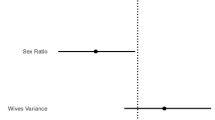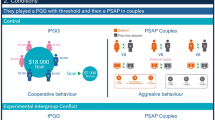Abstract
Sex differences in physical and indirect aggression have been found in many societies but, to our knowledge, have not been studied in a population of hunter-gatherers. Among Aka foragers of the Central African Republic we tested whether males physically aggressed more than females, and whether females indirectly aggressed more than males, as has been seen in other societies. We also tested predictions of an evolutionary theory of physical strength, anger, and physical aggression. We found a large male bias in physical aggression. Controlling for anger, we found an adult female bias in indirect aggression. Physical strength predicted anger, which predicted hitting, although results were sensitive to the inclusion or exclusion of traditional healers, who were physically and emotionally distinct from other Aka. With some important caveats, our results generally support the predicted sex differences in physical aggression and indirect aggression, and the predicted relationships among anger, strength, and aggression.



Similar content being viewed by others
Notes
The term pygmy is now viewed as derogatory, but no suitable replacement has yet emerged.
Note that we did not specify whether “most other Aka” included only Aka in one’s own age category.
References
Archer, J. (2004). Sex differences in aggression in real-world settings: a meta-analytic review. Review of General Psychology, 8(4), 291–322.
Archer, J. (2009). Does sexual selection explain human sex differences in aggression? The Behavioral and Brain Sciences, 32, 249–266.
Archer, J., & Coyne, S. (2005). An integrated review of indirect, relational, and social aggression. Personality and Social Psychology Review, 9(3), 212–230.
Archer, J., & Thanzami, V. (2007). The relation between physical aggression, size and strength among a sample of young Indian men. Personality and Individual Differences, 43, 627–633.
Bahuchet, S. (1985). Les pygmées Aka et la forêt Centrafricaine. Paris: Selaf.
Bahuchet, S. (1990). Food sharing among the pygmies of Central Africa. African Study Monographs, 11(1), 27–53.
Bandura, A. (1973). Aggression: A social learning analysis. Englewood Cliffs: Prentice-Hall.
Barry, H., Josephson, L., Lauer, E., & Marshall, C. (1976). Traits inculcated in childhood: cross-cultural codes 5. Ethnology, 15, 83–106.
Bowles, S. (2009). Did warfare among ancestral hunter-gatherers affect the evolution of human social behavior? Science, 324(5932), 1293–1298.
Campbell, A. (1999). Staying alive: evolution, culture, and women’s intrasexual aggression. The Behavioral and Brain Sciences, 22, 203–252.
Campbell, A., Muncer, S., Guy, A., & Banim, M. (1996). Social representations of aggression: crossing the sex barrier. European Journal of Social Psychology, 26(1), 135–147.
Card, N. A., Stucky, B. D., Sawalani, G. M., & Little, T. D. (2008). Direct and indirect aggression during childhood and adolescence: a meta-analytic review of gender differences, intercorrelations, and relations to maladjustment. Child Development, 79, 1185–1229.
Chagnon, N. A. (1997). Yanomamö (5th ed.). New York: Harcourt Brace.
Daly, M., & Wilson, M. (1988). Homicide. New York: Aldine de Gruyter.
Draper, P. (1978). The learning environment for aggression and anti-social behavior among the !Kung (Kalahari Desert, Botswana, Africa). In A. Montagu (Ed.), Learning non-aggression: The experience of non-literate societies (pp. 31–53). New York: Oxford University Press.
Eagly, A. H., & Wood, W. (1999). The origins of sex differences in human behavior: evolved dispositions versus social roles. American Psychologist, 54, 408–423.
Ember, C. R. (1978). Myths about hunter-gatherers. Ethnology, 17(4), 439–448.
Ember, C. R., & Ember, M. (1994). War, socialization, and interpersonal violence: a cross-cultural study. Journal of Conflict Resolution, 38(4), 620–646.
Ember, C. R., & Ember, M. (1997). Violence in the ethnographic record. In D. L. Martin & D. W. Frayer (Eds.), Troubled times: Violence and warfare in the past (pp. 1–20). Amsterdam: Gordon and Breach.
Fouts, H. N., & Lamb, M. E. (2009). Cultural and developmental variation in toddlers’ interactions with other children in two small-scale societies in Central Africa. European Journal of Developmental Science, 3, 259–277.
Gat, A. (1999). The pattern of fighting in simple, small-scale, prestate societies. Journal of Anthropological Research, 55, 563–583.
Hess, N. H. (2006). Informational warfare: The evolution of female coalitions and gossip. PhD Dissertation, University of California at Santa Barbara.
Hess, N. H. and Hagen, E. H. (n.d.) The impact of resource value, resource contestedness, and coalitions on gossiping. Under review.
Hewlett, B. S. (1991). Intimate fathers: The nature and context of Aka pygmy paternal infant care. Ann Arbor: The University of Michigan Press.
Hewlett, B. S. (1996). Cultural diversity among African pygmies. In S. Kent (Ed.), Cultural diversity among twentieth-century foragers (pp. 215–244). Cambridge: Cambridge University Press.
Hewlett, B. S., Lamb, M. E., Levendecker, B., & Scholmerich, A. (2000). Internal working models, trust, and sharing among foragers. Current Anthropology, 41(2), 287–296.
Hewlett, B. S., van de Koppel, J. M. H., & van de Koppel, M. (1986). Causes of death among Aka pygmies of the Central African Republic. In L. L. Cavalli-Sforza (Ed.), African pygmies (pp. 45–63). Orlando: Academic.
Hewlett, B. S., & Hewlett, B. L. (2008). A biocultural approach to sex, love, and intimacy in Central African foragers and farmers. In W. Jankowiak (Ed.), Intimacies: Love and sex across cultures (pp. 37–64). New York: Columbia University Press.
Hill, K., & Hurtado, A. M. (1996). Ache life history. New York: Aldine de Gruyter.
Kelly, R. (2000). Warless societies and the origin of war. Ann Arbor: University of Michigan Press.
Levy, R. I. (1978). Tahitian gentleness and redundant controls. In A. Montagu (Ed.), Learning non-aggression: The experience of non-literate societies (pp. 222–235). New York: Oxford University Press.
McCall, G. S., & Shields, N. (2008). Examining the evidence from small-scale societies and early prehistory and implications for modern theories of aggression and violence. Aggression and Violent Behavior, 13, 1–9.
Meehan, C. L. (2005). Multiple caregiving and its effect on maternal behavior among the Aka foragers and the Ngandu farmers of Central Africa. PhD dissertation, Washington State University.
Montagu, A. (Ed.). (1978). Learning non-aggression: The experience of non-literate societies. New York: Oxford University Press.
Sell, A. (2006). Regulating welfare tradeoff ratios: Three tests of an evolutionary-computational model of human anger. Ph.D. dissertation, University of California at Santa Barbara.
Sell, A., Cosmides, L., Tooby, J., Sznycer, D., von Rueden, C., & Gurven, M. (2008). Human adaptations for the visual assessment of strength and fighting ability from the body and face. Proceedings of the Royal Society of Biology, 276, 575–584.
Sell, A., Tooby, J., & Cosmides, L. (2009). Formidability and the logic of human anger. Proceedings of the National Academy of Sciences, 106(35), 15073–78.
Shannon, D. (1996). Early infant care among the Aka. PhD dissertation, Washington State University.
Smith, R. L., Rose, A. J., & Schwartz-Mette, R. A. (2009). Relational and overt aggression in childhood and adolescence: clarifying mean-level gender differences and associations with peer acceptance. Social Development. doi:10.1111/j.1467-9507.2009.00541.x.
Thomas, E. M. (1958). The harmless people. New York: Vintage Books.
Trivers, R. (1972). Parental investment and sexual selection. In B. Campbell (Ed.), Sexual selection and the descent of man, 1871-1971 (pp. 136–179). Chicago: Aldine.
Turnbull, C. M. (1965). The Mbuti pygmies: An ethnographic survey. New York: Anthropological Papers of the American Museum of Natural History (vol. 50, part 3).
Turnbull, C. M. (1978). The politics of non-aggression (Zaire). In A. Montagu (Ed.), Learning non-aggression: The experience of non-literate societies (pp. 161–221). New York: Oxford University Press.
Walker, P. L. (2001). A bioarchaeological perspective on the history of violence. Annual Review of Anthropology, 30, 573–596.
Wiessner, P. (2005). Norm enforcement among the Ju/’hoansi Bushmen: a case of strong reciprocity? Human Nature, 16, 115–145.
Wrangham, R. W., Wilson, M. L., & Mueller, M. N. (2006). Comparative rates of violence in chimpanzees and humans. Primates, 47, 14–26.
Acknowledgments
Funding provided by the College of Liberal Arts, Washington State University. We thank our Ngandu research assistants and the Aka participants.
Author information
Authors and Affiliations
Corresponding author
Rights and permissions
About this article
Cite this article
Hess, N., Helfrecht, C., Hagen, E. et al. Interpersonal Aggression among Aka Hunter-Gatherers of the Central African Republic. Hum Nat 21, 330–354 (2010). https://doi.org/10.1007/s12110-010-9094-0
Received:
Accepted:
Published:
Issue Date:
DOI: https://doi.org/10.1007/s12110-010-9094-0




